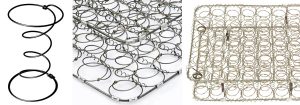 Bonnell Coil System,
Bonnell Coil System,The oldest type of coil used in mattresses is the Bonnell coil. Bonnell coil mattresses are often called “traditional mattresses” or “traditional innerspring mattresses.” Other types of coils have been developed since, but they all originate in the Bonnell coil.
Bonnell coils themselves were developed from buggy seat springs. They are hourglass shaped. The ends are knotted, the end of the wire twisted around the coil wire, making a full circle (see the single coil in the illustration above). The coils are attached to each other in rows by a helical wire (see middle picture). And all the rows together in a heavy wire (or perimeter rod) frame form the innerspring unit.
The hourglass shape of a Bonnell coil gives it a dual action. The narrower middle is “softer” with an initial yield when a weight is placed on it. Then the wider ends increase resistance for “deep down” support.
The narrow middle section is a weak point in this type of coil, making it prone to distortion or breakage leading to mattress sagging. Nevertheless, Bonnell mattresses give good support when new. Thicker-gauge wire and/or a less-pronounced hourglass figure make a Bonnell coil more durable. At the same time, this makes the innerspring firmer. This is the reason Bonnell coils are usually found in firmer mattress models. A taller coil or fewer turns can make heavier-gauge coils less firm without sacrificing durability.
Bonnell coils cost less to manufacture and assemble than other types. Therefore they are usually found in lower-priced entry level innerspring mattresses. If a sleeper or a couple are not too heavy, a well-designed and made Bonnell coil mattress can last a reasonably long time.
This entry was posted on Wednesday, October 22nd, 2014 at 9:54 PM and is filed under coils, innerspring, innerspring mattress, springs . You can follow any responses to this entry through the RSS 2.0 feed. You can leave a response, or trackback from your own site.

Get New Post Notification via Email:

13 thoughts on “Bonnell Coils”